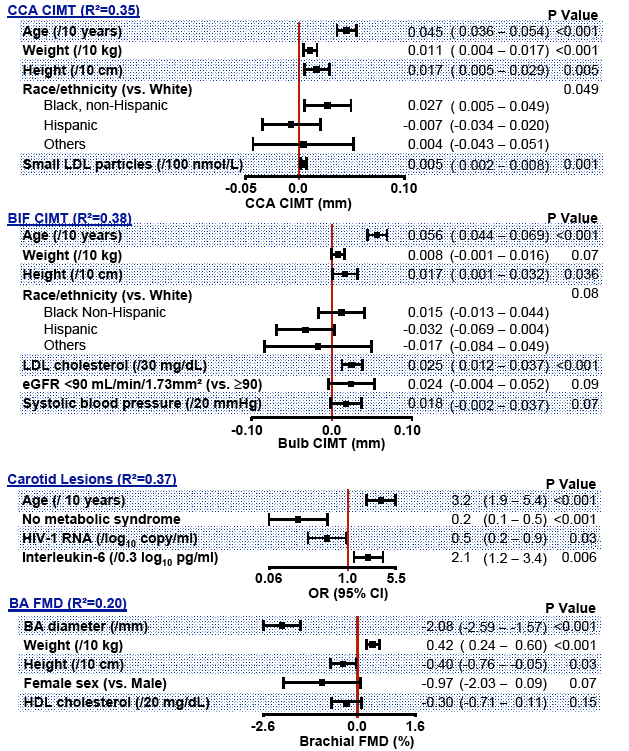 |
 |
 |
| |
Ultrasonographic Measures of Cardiovascular Disease Risk in a Modern Cohort of Antiretroviral Treatment (ART)-Naïve Individuals with HIV Infection: Baseline Results from ACTG Study 5260s
|
| |
| |
James H. Stein1, Todd T. Brown2, Heather Ribaudo3, Yun Chen3, Mingzhu Yan4, Elizabeth Lauer-Brodell1, Grace A. McComsey5,Michael P. Dube4, Howard N. Hodis4, Judith S. Currier6
1University of Wisconsin School of Medicine and Public Health, 2Johns Hopkins University, 3Harvard School of Public Health, 4Keck School of Medicine at the University of Southern California, 5Case School of Medicine, 6David Geffen School of Medicine at University of California - Los Angeles

ABSTRACT
Background: In individuals with HIV infection, HIV-related factors including inflammation and immune activation have been postulated to predict cardiovascular disease (CVD) risk. To date, most studies have focused on patients receiving ART.
Methods: Participants were ART-naïve HIV-infected individuals without known CVD or diabetes mellitus who enrolled in a randomized treatment trial (A5257). Prior to ART initiation, carotid artery intima-media thickness (CIMT) and brachial artery flow-mediated dilation (FMD) images were obtained at 26 U.S sites. Multiple demographic, anthropomorphic, and laboratory
parameters were measured, including body composition by DXA and CT, lipoproteins by NMR spectroscopy, immune activation markers
(%CD38+DR+ on CD4+ and CD8+ T cells), and inflammatory markers (hsCRP, IL-6). 10-year risk of coronary death/myocardial infarction was estimated using the Framingham risk score (FRS). Univariate associations were evaluated using non-parametric k-sample tests; adjusted analyses used linear models.
Results: The 331 subjects were a median (1st-3rd quartile) of 36 (28-45) years old. They were 89% male, 44% white, 32% black, 20% Hispanic. HIV-1 RNA was 4.5 (4.0-5.1) log10 copies/mL. CD4 cell count was 349 (207-455)/mm3; 23% had a prior AIDS diagnosis. FRS was 1.0 (1.0-3.0)% and 38% were current smokers. Except for a mildly low HDL cholesterol level of 38 (31-45) mg/dL, traditional CVD risk factor values were normal. Common and bulb CIMT were 0.64 (0.59-0.70) and 0.74 (0.65-0.82) mm respectively; 27 (8%) had carotid plaques. FMD was 4.5 (3.0-6.3)%. Common and bulb CIMT values were higher and plaques were more prevalent with aging
(p<0.001). FMD was lower with aging (p=0.009). Those with a FRS >6% (N=44) had higher common and bulb CIMT (p<0.001), plaque prevalence (p<0.001), and lower FMD (p=0.035). Independent associations with common CIMT were identified for age, height, weight, black race, FRS, and small LDL particles. These were the same associations for bulb CIMT as well as estimated GFR and LDL cholesterol (rather than small LDL particles). After adjustment for traditional risk factors, independent associations of HIV disease activity, inflammation, or immune activation with CIMT or FMD were not apparent (p>0.12).
Conclusions: In a modern cohort of ART-naive HIV-infected individuals, CIMT and brachial FMD were associated with traditional CVD risk factors, rather than markers of HIV disease activity, inflammation, or immune activation.








|
| |
|
 |
 |
|
|